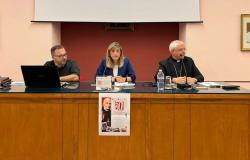“Find me”. It is the invitation, the exhortation, the heartfelt appeal that God, for millennia, has addressed to the women and men of the earth. A God who, according to Christian doctrine, cannot help but love us, despite our deafness and resistance. Finding God is not easy, it requires will, determination, courage, abandonment: a path that is not only arduous, but often dark, as the mystics who have lived the long nights of faith testify.
In 2024 “Find me!” is the theme proposed for the long night of the churches which took place in Acireale on Friday 7 June. The event, since 2016, has taken place on the same day throughout Italy, involving more and more churches in the area, and exciting believers and non-believers alike, thanks to the experiential style of the journey that combines art, music, meditation and silence.
An opportunity to learn about the beauties of our churches, often unknown or made opaque by the blindness of custom. And even more, to refine the mind and heart on the path of spirituality.
The night of the churches in five stages
This year too the initiative was promoted byCento Campanili association, which made use of the collaboration of the Cultural Heritage Office of the Diocese, the Ecclesial Cultural Park of the lands of Etna and Alcantara, the Stoà Sicula association, the Camillian brothers, the Friars Minor and the Diocesan Caritas.
The meeting point for the start of the route, divided into five stages, is at 8.30pm, but a large group of people from Acirea, coming from the surrounding areas and from Catania, had already gathered in front of the bishop’s palace for some time. The joyful sound of the bells of the churches involved welcomes and marks the beginning of the journey.
Night of the churches in Acireale: first stop
“Find me in the intimacy of the heart” is the title of the first stage, the chosen location is the Bishop’s Palace, a point of reference and heart for all the Christians of the diocese. Monsignor Antonino Raspanti, bishop of our diocese for 12 years, welcomed us. After the greetings and the presentation of the program by the president of the Cento Campanili association, Maria Rosa Licciardello, we move on to art with the description of the palace and some paintings that decorate the meeting hall: the portraits of the first two bishops, Genuardi and Arista, while on the opposite wall there is an 18th century painting depicting a good death: the dying person is not alone in this ordeal. On earth there are some clerics, while in heaven the Madonna appears, ready to welcome him. This moment is entrusted to Roberta Leonardi, president of Stoà Sicula.

Mgr. continues. Raspanti: the small chapel of the palace is the heart of the diocesan community, the place where he begins his day in front of the tabernacle, next to the relics of contemporary saints such as Allegra and Puglisi, and with the vision of some paintings with a strong meaning. He focuses on the description of a crucifixion, painted by his New York Jewish friend Paul Weingarten. Christ is seen from behind, but with his face he tries to overcome the arm of the cross to look for each of us with his eyes. At the foot of the cross Mary, John and a “scapegoat” of Jewish tradition. “God wants to be sought, because He has already found me” concludes Raspanti.
A small window connects the chapel with the altar of the Blessed Sacrament in the cathedral, a vision that strengthens the bond with God and with the entire community of the diocese.
Night of the churches in Acireale: second stage
Together we move towards the church of Saints Peter and Paul, home of the second stage entitled “Find me in pain”.
Inside the famous statue of the “Sicilian Christ at the column”, created in the 1600s, by Friar Umile from Petralia and characterized by strong pathos, typical of the dramatically scenographic representations of the Spanish seventeenth century. Friar Umile created about 33 of them and tradition says that while he sculpted, he prayed.
The theological and artistic presentation is entrusted to Don Antonio Agostini, art historian and current secretary of the bishop. The sufferings of Christ are the expression of his love for him, and as St. Bridget wrote, an invitation to introspection, to repentance of the heart and to conversion.

And the testimony of Don Dario Malizia, a Camillian, who has always been close to the sick, the dying, the last, continues on the same theme. Christ was nailed to the cross, as many sick people are “nailed to bed”, sometimes alone. But human or divine suffering, even if long and painful, is still “transient”. As Don Tonino Bello remembered, afterwards there will be lightness and brightness of the opening skies. The soul, accompanied by celestial music, such as that played on the organ by Giuseppe Grasso, will be welcomed into the eternal home.
Night of the churches in Acireale: third stage
From the omega we return to the alpha, to continue with the third stage entitled “find me in sharing”. On the facade of the cathedral a marble group speaks to us of life, of the annunciation, of the beginning of Christian life. The protagonist is Maria, the teacher of sharing this moment of reflection. The always large group is distributed between the seats of the apse and the first rows of the benches to admire the frescoes by the Filocamo brothers on the life of Mary. And also listen to Claudia Leonardi’s description of Stoà Sicula. Unfortunately, the amplification of the microphones and perhaps the acoustics of the apse made it very difficult to understand the words even in the following speech, edited by Don Orazio Tornabene, director of Caritas.

The beauty and expressiveness of Filocamo’s frescoes from the first half of the eighteenth century have reduced the discomfort caused by current technology. Just look at the scenes dedicated to Maria to understand what sharing means. The meeting with Elizabeth is a sharing of joy that will culminate in the Magnificat. In the birth of Jesus, in the adoration of the wise men, in the presentation at the temple, Mary is always present and in two scenes she holds Jesus in her arms. But the attitude of her body and her arms stretched forward say that she made this child for us and shares it with us. From possession to sharing, as Jesus suggests to the young man who asks for advice on having eternal life.
The polyphonic choir Jonia, the oldest choir in Sicily, concludes, directed by maestro Giuseppe Cristaudo with songs by Jovi Busto, Ola Gjeilo, Steve Dobrogosz.
Night of the churches in Acireale: fourth stage
After so many lights, colours, music, opening skies, saints, the Trinity, life and triumphs in heaven, we gather in silence to experience the fourth stage, entitled “Find me in Silence”, at the church of S. Vincenzo Ferreri. This is a small church in via Currò, where the Blessed Sacrament is always exposed, to offer the opportunity to those who wish to meet Jesus in closeness and intimacy of heart.
Silence is relationship, an intimate relationship with ourselves and with others, Don Carmelo Raspa reminds us. He mentions Elijah and his encounter with God characterized by a whispering silence. Even when the heart is agitated by strong and conflicting feelings, God comes to the rescue who, as in Psalm 107, “reduces the storm to silence” and the silence is transformed into whispered praise, an intimate dimension in those he loves. A few minutes of silence follow, at times interrupted by the din of life that continues in the nearby streets.
Night of the churches in Acireale: fifth and final stage
And always in silence we move towards the fifth and final stage entitled “find me in testimony and peace”, at the basilica of S. Sebastiano.
Alessio Barbagallo by Stoa Sicula illustrates the style and themes proposed in the frescoes of the apse, by Paolo Vasta and his school, in the mid-18th century. The painter from Acivia met other painters in Rome and learned new techniques, which he will apply upon his return to his hometown. The frescoes tell the story of the double martyrdom of the warrior Sebastian, who, after meeting Christ, becomes his witness. The choice of colors with the predilection for warm ones from yellow to orange to the various shades of red, as well as the use of lights that illuminate the bloody scenes of martyrdom, are an expression of Paolo Vasta’s style, capable of combining tradition with innovation.
Fra Giuseppe Garofalo of the Friars Minor is entrusted with the task of speaking to us about testimony and peace. To practice both, it is necessary to have experienced the encounter with God, the one that profoundly transforms one’s life. Except for St. Paul, as his hagiography tells us, the path is not immediate, but in successive stages and is achieved through experiences that God makes us live. Just as being builders of peace, it is not just living, but the result of a lifestyle, which finds the source of inspiration in the Gospel, as happened for Francis of Assisi, and as suggested by Jesus himself, in the passage taken from Gospel of Matthew, and in the 17th century admirably painted by Caravaggio in the “Seven Works of Mercy.”
It’s midnight and the church is still full of people, attentive and involved. The best way to “testify” to the organizers your appreciation for the work they have done.
Rosa Maria Garozzo













